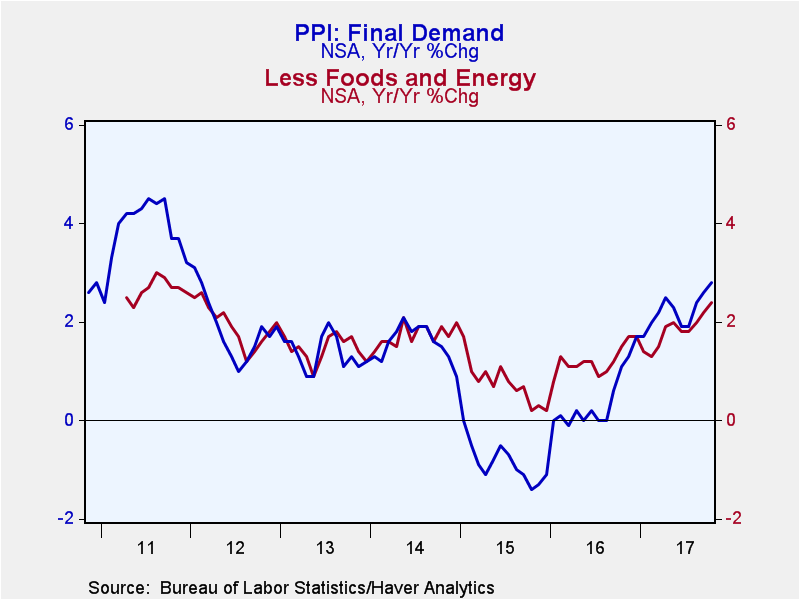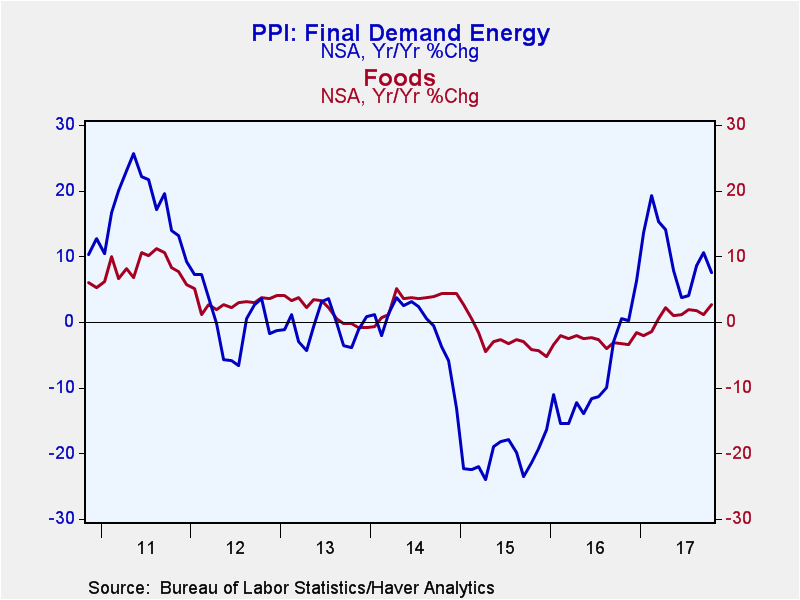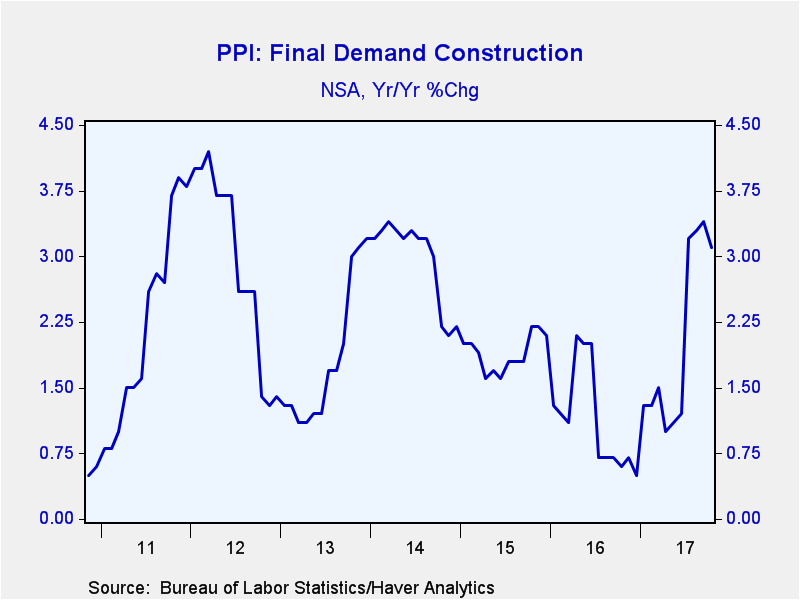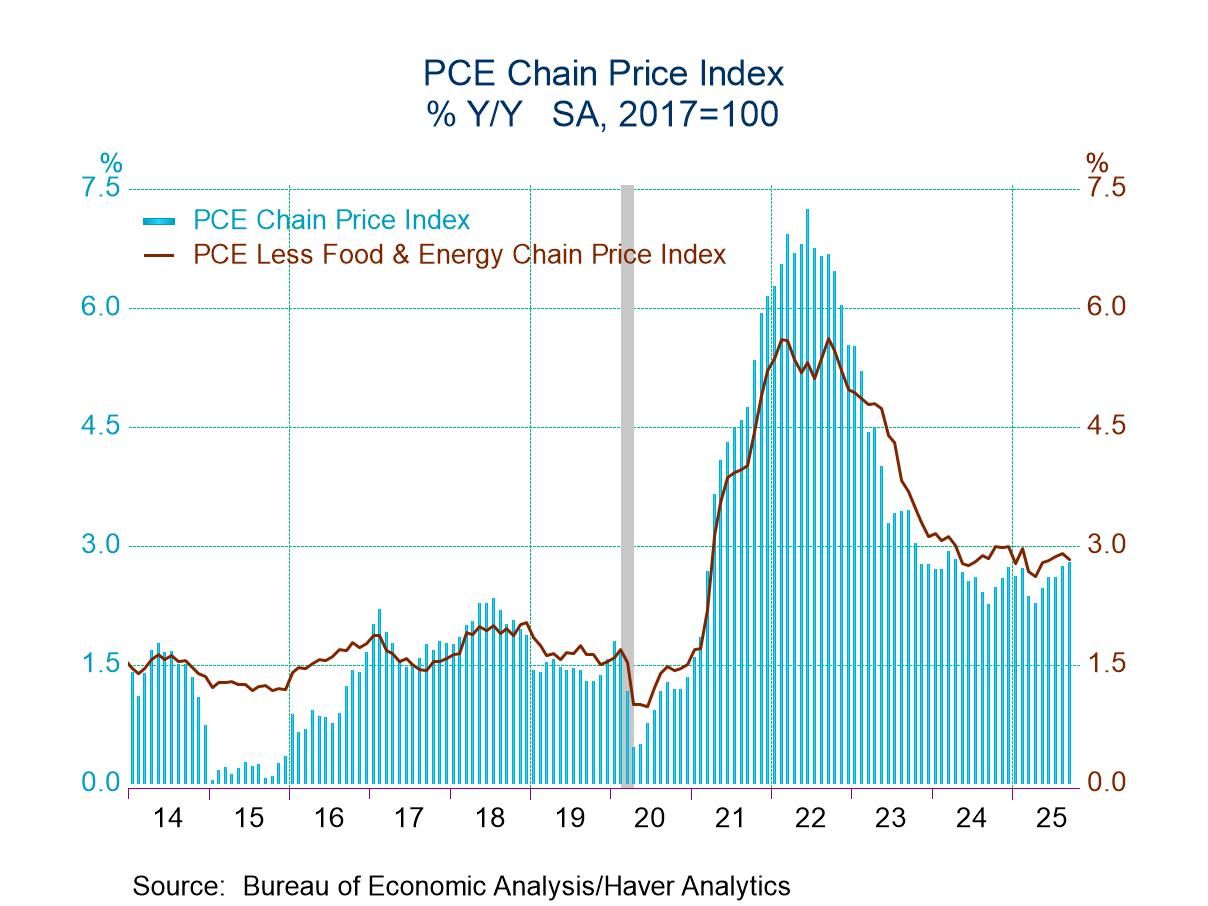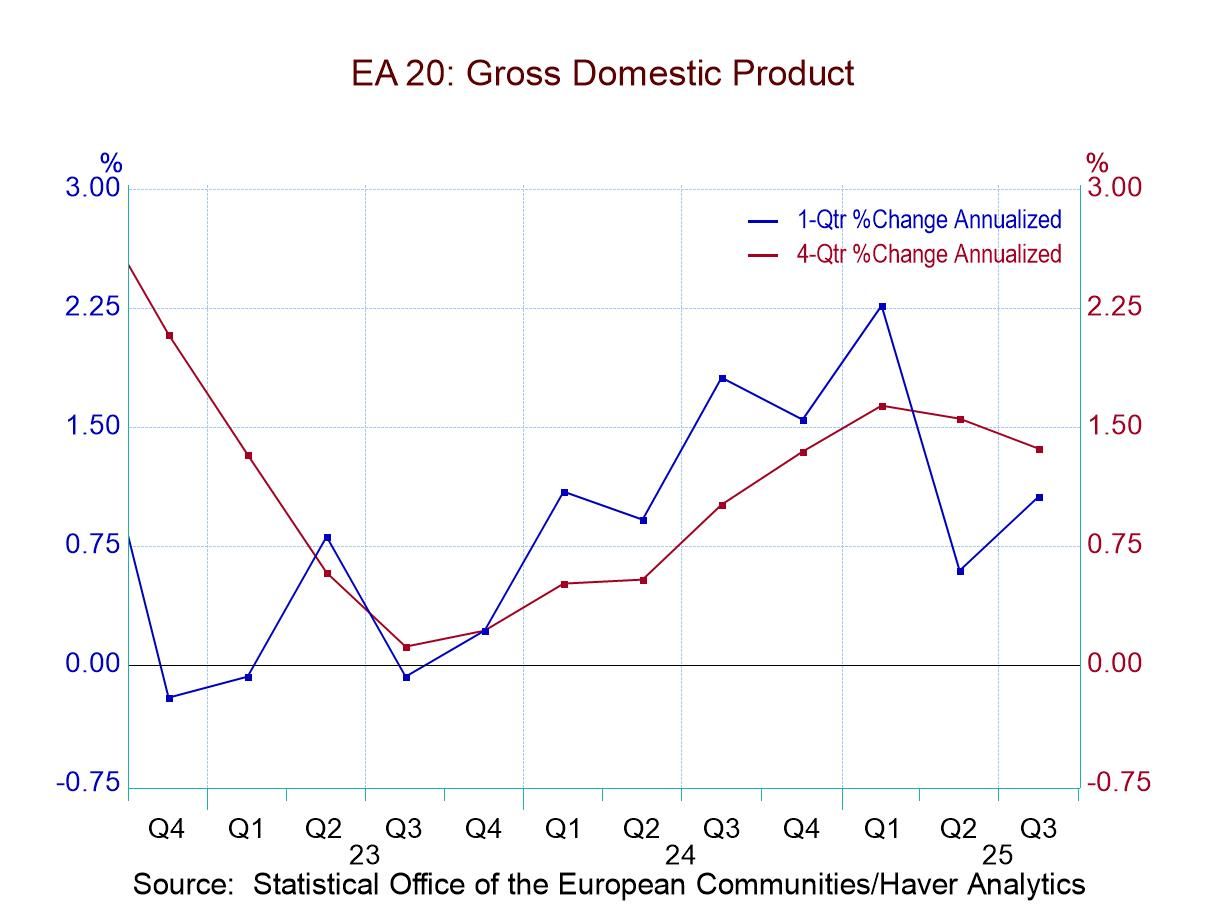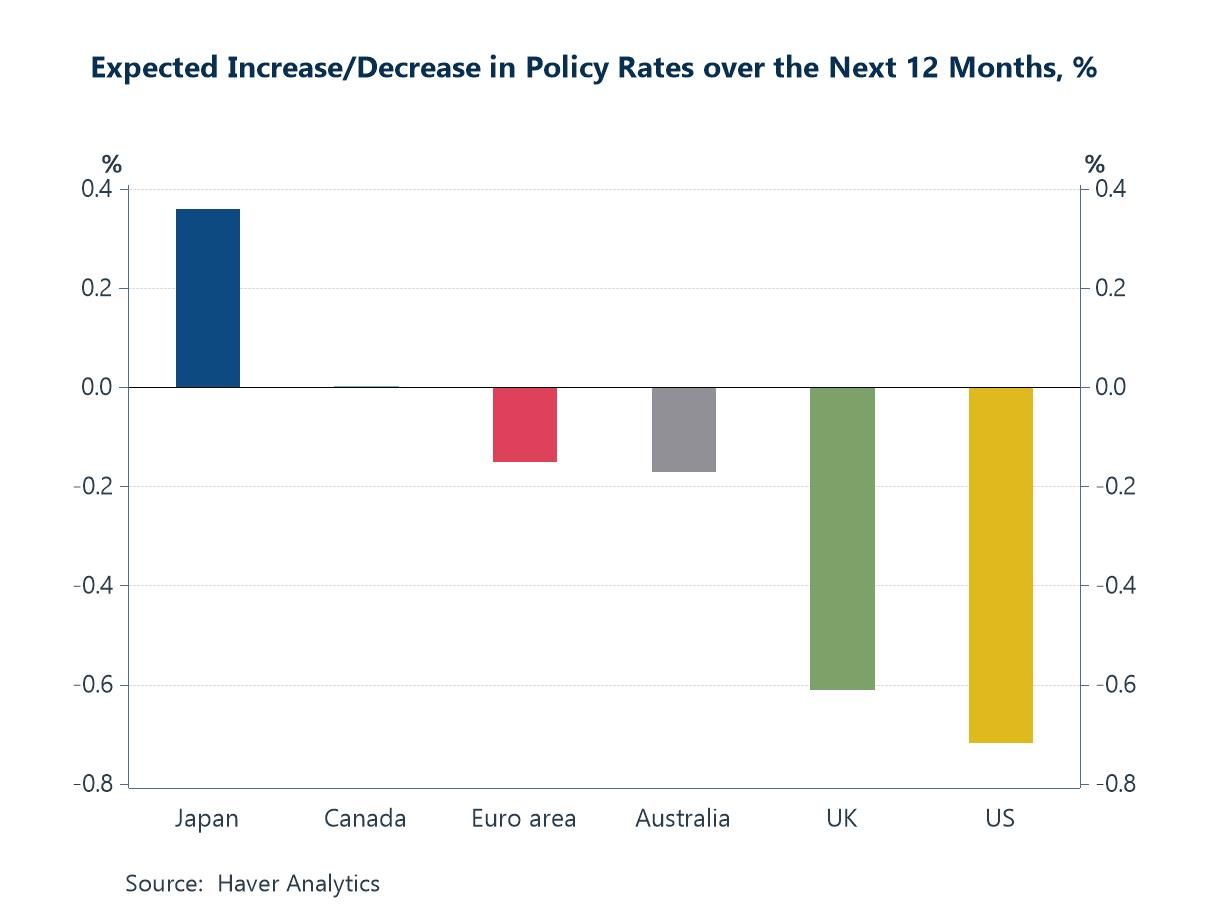 Global| Nov 14 2017
Global| Nov 14 2017U.S. Producer Pricing Power Strengthens Yet Again
by:Tom Moeller
|in:Economy in Brief
Summary
The headline Final Demand Producer Price Index using new methodology increased 0.4% during October, the same as in September. These remain the strongest gains since April and pulled the y/y rise to 2.8%, the strongest since February [...]
The headline Final Demand Producer Price Index using new methodology increased 0.4% during October, the same as in September. These remain the strongest gains since April and pulled the y/y rise to 2.8%, the strongest since February 2012. A 0.1% rise had been expected in the Action Economics Forecast Survey. The PPI excluding food & energy also improved 0.4% (2.4% y/y) for a second month, twice the gain expected. Using the old methodology for the Producer Price Index, prices increased 0.2% (2.9% y/y) following a 0.8% gain. Excluding food & energy, the index rose 0.3% (2.0% y/y) after a 0.2% rise.
An updated measure of core producer price inflation is the overall index excluding food, energy and trade services. It increased 0.2% (2.3% y/y) for a third straight month.
Final demand goods prices rose 0.3% (3.2% y/y), the weakest rise in three months. The price index excluding food & energy increased 0.3% for a second month. The 2.3% y/y gain was improved versus stability in 2015.
Food prices increased 0.5% (2.6% y/y) following no change. Beef & veal prices jumped 6.1% (4.8% y/y) after a 2.2% rise. Egg prices strengthened by one-quarter and have more than doubled during the last year. Dairy product prices eased 0.9% (2.9% y/y) while fresh fruit & melon costs declined 8.3% (+4.9% y/y). Energy prices held steady (7.6% y/y) after two months of strong gain. Gasoline prices declined 4.6% (+9.2% y/y) and reversed September's rise. Home heating oil prices jumped 14.5% (20.6% y/y) following a 4.1% decline. Natural gas prices improved 1.1% (+4.4% y/y) after four straight months of decline. Electric power costs improved 0.2% (2.4% y/y) and reversed the prior month's fall.
Nondurable consumer goods prices less food & energy surged 1.2% (4.0% y/y) following a 0.1% uptick. Durable consumer goods prices declined 0.3% (+1.0% y/y) after a 0.4% rise. Household furniture costs held steady (+1.7% y/y) after easing 0.1%. Passenger car prices were unchanged (-0.4% y/y) after a 0.2% rise. Light truck prices fell 1.3% (+0.8% y/y), the first decline in three months. Capital equipment prices slipped 0.1% (+0.9% y/y) after two months of 0.1% increase.
Final demand for services prices strengthened 0.5% (2.4% y/y), the strongest gain in six months. Trade services prices surged 1.1% (3.0% y/y) after a 0.8% increase. Private passenger transportation prices strengthened 3.2% (4.8% y/y), also the firmest rise in six months.
Final demand construction prices moved 0.5% higher (3.1% y/y) as prices for private capital investment gained 0.6% (3.1% y/y). Prices for public investment increased 0.5% (3.1% y/y).
Prices for intermediate demand for goods strengthened 1.0% (5.0% y/y) following two months of firm increase.
The PPI data are contained in Haver's USECON database with further detail in PPI and PPIR. The expectations figures are available in the AS1REPNA database.
| Producer Price Index (SA, %, New Methodology) | Oct | Sep | Aug | Oct Y/Y | 2016 | 2015 | 2014 |
|---|---|---|---|---|---|---|---|
| Final Demand | 0.4 | 0.4 | 0.2 | 2.8 | 0.5 | -1.0 | 1.8 |
| Excluding Food & Energy | 0.4 | 0.4 | 0.1 | 2.4 | 1.3 | 0.8 | 1.8 |
| Excluding Food, Energy & Trade Services | 0.2 | 0.2 | 0.2 | 2.3 | 1.2 | 0.6 | 1.2 |
| Goods | 0.3 | 0.7 | 0.5 | 3.2 | -1.5 | -4.9 | 1.4 |
| Foods | 0.5 | 0.0 | -1.3 | 2.6 | -3.2 | -3.1 | 3.7 |
| Energy | 0.0 | 3.4 | 3.3 | 7.6 | -8.2 | -25.6 | -3.2 |
| Goods Excluding Food & Energy | 0.3 | 0.3 | 0.2 | 2.3 | 0.8 | 0.4 | 1.6 |
| Services | 0.5 | 0.4 | 0.1 | 2.4 | 1.5 | 1.0 | 1.9 |
| Trade Services | 1.1 | 0.8 | 0.0 | 3.0 | 1.5 | 1.4 | 2.0 |
| Construction | 0.5 | 0.1 | 0.3 | 3.1 | 1.3 | 3.2 | 1.9 |
| Intermediate Demand - Processed Goods | 1.0 | 0.5 | 0.4 | 5.0 | -5.7 | -14.0 | 1.1 |
Tom Moeller
AuthorMore in Author Profile »Prior to joining Haver Analytics in 2000, Mr. Moeller worked as the Economist at Chancellor Capital Management from 1985 to 1999. There, he developed comprehensive economic forecasts and interpreted economic data for equity and fixed income portfolio managers. Also at Chancellor, Mr. Moeller worked as an equity analyst and was responsible for researching and rating companies in the economically sensitive automobile and housing industries for investment in Chancellor’s equity portfolio. Prior to joining Chancellor, Mr. Moeller was an Economist at Citibank from 1979 to 1984. He also analyzed pricing behavior in the metals industry for the Council on Wage and Price Stability in Washington, D.C. In 1999, Mr. Moeller received the award for most accurate forecast from the Forecasters' Club of New York. From 1990 to 1992 he was President of the New York Association for Business Economists. Mr. Moeller earned an M.B.A. in Finance from Fordham University, where he graduated in 1987. He holds a Bachelor of Arts in Economics from George Washington University.


